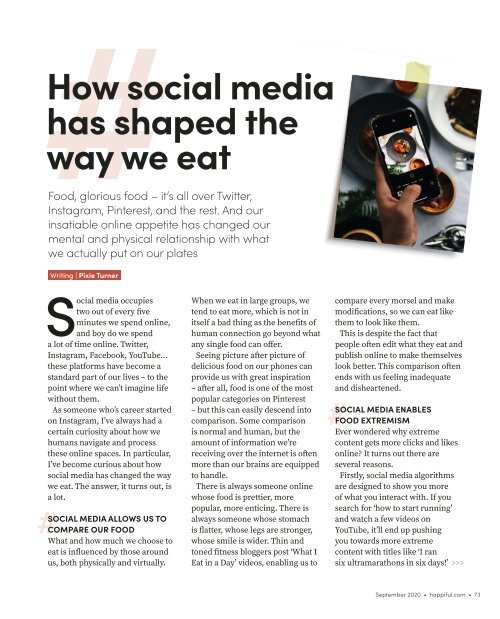You also want an ePaper? Increase the reach of your titles
YUMPU automatically turns print PDFs into web optimized ePapers that Google loves.
How social media<br />
has shaped the<br />
way we eat<br />
Food, glorious food – it’s all over Twitter,<br />
Instagram, Pinterest, and the rest. And our<br />
insatiable online appetite has changed our<br />
mental and physical relationship with what<br />
we actually put on our plates<br />
Writing | Pixie Turner<br />
Social media occupies<br />
two out of every five<br />
minutes we spend online,<br />
and boy do we spend<br />
a lot of time online. Twitter,<br />
Instagram, Facebook, YouTube…<br />
these platforms have become a<br />
standard part of our lives – to the<br />
point where we can’t imagine life<br />
without them.<br />
As someone who’s career started<br />
on Instagram, I’ve always had a<br />
certain curiosity about how we<br />
humans navigate and process<br />
these online spaces. In particular,<br />
I’ve become curious about how<br />
social media has changed the way<br />
we eat. The answer, it turns out, is<br />
a lot.<br />
SOCIAL MEDIA ALLOWS US TO<br />
COMPARE OUR FOOD<br />
What and how much we choose to<br />
eat is influenced by those around<br />
us, both physically and virtually.<br />
When we eat in large groups, we<br />
tend to eat more, which is not in<br />
itself a bad thing as the benefits of<br />
human connection go beyond what<br />
any single food can offer.<br />
Seeing picture after picture of<br />
delicious food on our phones can<br />
provide us with great inspiration<br />
– after all, food is one of the most<br />
popular categories on Pinterest<br />
– but this can easily descend into<br />
comparison. Some comparison<br />
is normal and human, but the<br />
amount of information we’re<br />
receiving over the internet is often<br />
more than our brains are equipped<br />
to handle.<br />
There is always someone online<br />
whose food is prettier, more<br />
popular, more enticing. There is<br />
always someone whose stomach<br />
is flatter, whose legs are stronger,<br />
whose smile is wider. Thin and<br />
toned fitness bloggers post ‘What I<br />
Eat in a Day’ videos, enabling us to<br />
compare every morsel and make<br />
modifications, so we can eat like<br />
them to look like them.<br />
This is despite the fact that<br />
people often edit what they eat and<br />
publish online to make themselves<br />
look better. This comparison often<br />
ends with us feeling inadequate<br />
and disheartened.<br />
SOCIAL MEDIA ENABLES<br />
FOOD EXTREMISM<br />
Ever wondered why extreme<br />
content gets more clicks and likes<br />
online? It turns out there are<br />
several reasons.<br />
Firstly, social media algorithms<br />
are designed to show you more<br />
of what you interact with. If you<br />
search for ‘how to start running’<br />
and watch a few videos on<br />
YouTube, it’ll end up pushing<br />
you towards more extreme<br />
content with titles like ‘I ran<br />
six ultramarathons in six days!’ >>><br />
<strong>September</strong> <strong>2020</strong> • happiful.com • 73

















